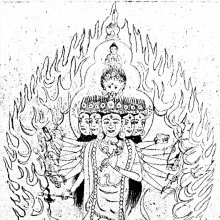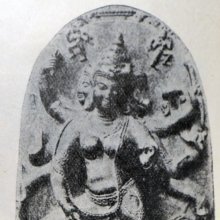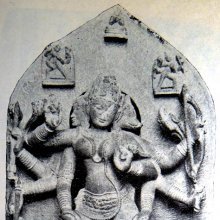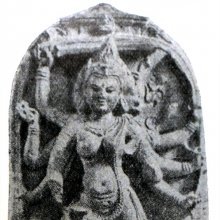Dashabhujasita, Daśabhujasita, Dashabhuja-sita: 1 definition
Introduction:
Dashabhujasita means something in Buddhism, Pali. If you want to know the exact meaning, history, etymology or English translation of this term then check out the descriptions on this page. Add your comment or reference to a book if you want to contribute to this summary article.
The Sanskrit term Daśabhujasita can be transliterated into English as Dasabhujasita or Dashabhujasita, using the IAST transliteration scheme (?).
Images (photo gallery)
In Buddhism
Tibetan Buddhism (Vajrayana or tantric Buddhism)
Source: archive.org: The Indian Buddhist IconographyDaśabhujasita (दशभुजसित) or Daśabhujasitamārīcī is a variety of Mārīcī: one of the various emanations of Vairocana, as mentioned in the 5th-century Sādhanamālā (a collection of sādhana texts that contain detailed instructions for rituals).—Her Colour is white; she has five faces, ten arms and four legs.
Daśabhujasita is described in the Sādhanamālā as follows:—
[The most important feature of this variety is that she is endowed with four legs. She has five faces. The principal face is white, the right is blue, the left is red and distorted sow-like, the face behind is green, and the face above is yellow and bears the triśikhā (three tufts of hair) and the jaṭāmukuṭa. The five right hands hold the sun, the blue vajra, the arrow, the goad and the needle while the five left hands carry the moon, the bow, the Aśoka bough, the noose with the tarjanī and the string. She rides a chariot drawn by seven pigs, and tramples under her feet the four Hindu gods Indra, Śiva, Viṣṇu and Brahmā. She bears the effigy of Vairocana on her crown.
The sādhanas further add that she should be accompanied by three other goddesses:
1: The first is blue in colour, and rides upon a Makara. Her face is misshapen like that of a sow, and she carries the vajra in one hand and the tarjanī in the other.
2: The second goddess appears to the right of Mārīcī, wears celestial ornaments, is ruddy in colour with one face misshapen like that of a sow.
3: The third goddess appears to the left of Mārīcī. She is of red colour, with one face misshapen like that of a sow, and four arms. The two principal hands are engaged in drawing to the full the bow charged with an arrow, while the remaining two hold the vajra in the right and the Aśoka bough in the left. Below the seven pigs drawing the chariot are the Navagrahas or the Nine Planets, and various diseases and disasters in human shape lie flat on the ground.
The sādhanas do not give the names of the attendant deities, which are only three in number. It is possible that these three are the members of the Varttālī group.]

Tibetan Buddhism includes schools such as Nyingma, Kadampa, Kagyu and Gelug. Their primary canon of literature is divided in two broad categories: The Kangyur, which consists of Buddha’s words, and the Tengyur, which includes commentaries from various sources. Esotericism and tantra techniques (vajrayāna) are collected indepently.
See also (Relevant definitions)
Partial matches: Dashabhuja, Sita.
Starts with: Dashabhujasitamarici.
Full-text: Dashabhujasitamarici, Marici.
Relevant text
Search found 1 books and stories containing Dashabhujasita, Daśabhujasita, Dashabhuja-sita, Daśabhuja-sita, Dasabhujasita, Dasabhuja-sita; (plurals include: Dashabhujasitas, Daśabhujasitas, sitas, Dasabhujasitas). You can also click to the full overview containing English textual excerpts. Below are direct links for the most relevant articles:
The Indian Buddhist Iconography (by Benoytosh Bhattachacharyya)



